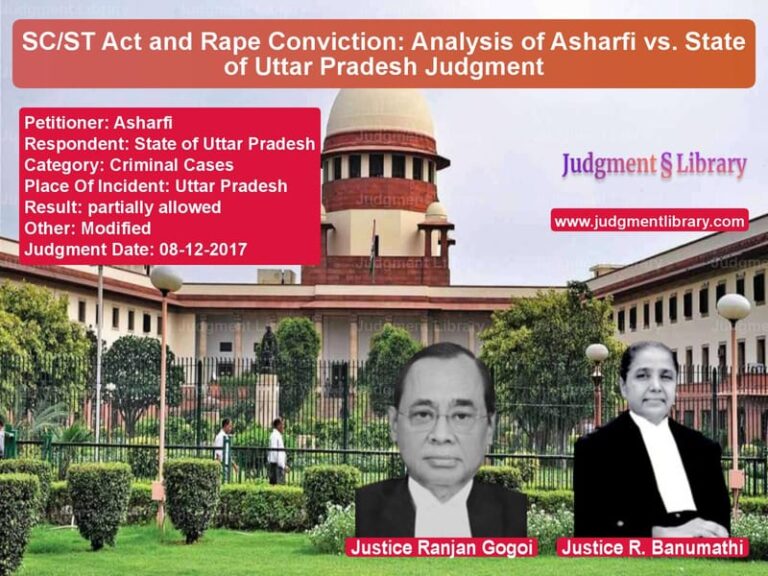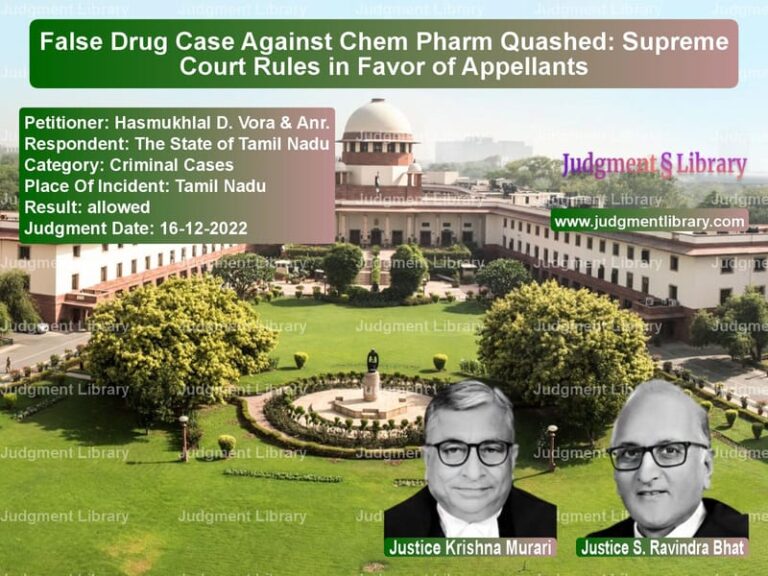Supreme Court Ruling on Land Acquisition and Compensation Calculation
The case of Manimegalai v. The Special Tahsildar (Land Acquisition Officer) Adi Dravidar Welfare revolved around a dispute regarding the compensation rate for land acquired by the Government of Tamil Nadu. The appellant, Manimegalai, had sought higher compensation for her land, which was acquired for the purpose of providing house sites to the landless poor. The compensation determined by the Land Acquisition Officer was deemed inadequate by the appellant, prompting a series of legal proceedings. The Supreme Court was called upon to evaluate whether the compensation awarded was just and reasonable under the provisions of the Land Acquisition Act, 1894.
Background of the Case
The Tamil Nadu Government issued a notification for the acquisition of dry lands on 15 September 1993 under Section 4(1) of the Land Acquisition Act, 1894, for the purpose of providing house sites to landless Adi Dravidas in Acharapakkam Village. The land belonging to Manimegalai, along with several others, was part of this acquisition. The area of land in question was 4.30 hectares (10.62 acres), and the land was categorized as ‘punja’ land, meaning dry, uncultivated land.
The Land Acquisition Officer determined the compensation for the land at Rs. 400 per cent, a figure that the appellant considered grossly inadequate. In response, the appellant sought a reference under Section 18 of the Land Acquisition Act, claiming that the market value of the land at the time of acquisition was not less than Rs. 20,000 per cent.
The case proceeded to the Subordinate Court, Madurantagam, where the learned judge awarded compensation at Rs. 2,500 per cent along with additional statutory benefits. The respondent, dissatisfied with this decision, appealed to the High Court, which reduced the compensation to Rs. 1,670 per cent. The appellant then filed a special leave petition to the Supreme Court, challenging the reduction of compensation.
Arguments by the Appellant (Manimegalai)
The appellant, represented by counsel Mr. Prabhakar, argued that:
- The compensation awarded by the Land Acquisition Officer was inadequate and did not reflect the true market value of the land.
- The compensation should be based on the potential use of the land, as the land in question was located near a National Highway and had great potential for residential development.
- Comparative land sales, such as those in S. No. 323, where land was sold for Rs. 4,919 per cent, were not considered by the authorities.
- The appellant contended that the respondent’s reliance on a sale deed dated 15 April 1993 for the valuation was misguided, as the lands in that sale transaction were not comparable to the acquired land.
Arguments by the Respondent (The Special Tahsildar)
The respondent, represented by the Special Tahsildar’s office, countered by asserting that:
- The compensation awarded was in line with the prevailing market rates at the time of acquisition, as determined by sale transactions in nearby areas.
- The appellant’s land was primarily agricultural and did not have the same commercial potential as lands adjacent to major roads and highways.
- The respondent maintained that the compensation was not excessively low, considering the land was acquired for public use to benefit landless poor people.
- The respondent further argued that the appellant’s land had not been fully acquired, and the compensation had been calculated for the acquired portion, not the remaining land.
Supreme Court’s Judgment
The Supreme Court, after hearing the arguments from both parties, delivered a detailed judgment addressing the key issues of compensation calculation, the legal standards for assessing market value, and the treatment of land acquired for public purposes.
1. The Legal Framework for Compensation
The Court emphasized that compensation must be fair and reasonable and that it should reflect the market value of the acquired land. The judgment reiterated the principles outlined in Shiv Raj v. Union of India that compensation must be assessed based on the land’s highest and best use at the time of acquisition. The Court held:
“In cases of land acquisition, the compensation should reflect not only the current market value but also the potential of the land for future use. The land in question, though acquired for public use, has great potential for development and should be valued accordingly.”
2. Assessment of Market Value
The Supreme Court disagreed with the High Court’s reduction of compensation to Rs. 1,670 per cent. The Court noted that the sale transactions cited by the appellant, where land was sold at higher rates, were more reflective of the land’s true market value. The Court observed:
“The market value of land is not to be assessed based on the price at which it was acquired by the government, but on the potential value it holds in the open market, considering its location, proximity to infrastructure, and future developmental potential.”
3. Importance of Location and Development Potential
The Court took into account the proximity of the acquired land to the National Highway, which greatly enhanced its development potential. The Court stated:
“The acquired land, located near major roads and highways, holds substantial potential for residential and commercial development. This must be considered when determining the compensation to be paid to the landowner.”
4. Final Compensation Calculation
The Court increased the compensation rate to Rs. 2,500 per cent, as initially determined by the Subordinate Judge. The Court noted that the sale transactions of nearby land had shown values of Rs. 4,000 per cent, and the compensation awarded should reflect this increase. It ruled:
“The compensation of Rs. 2,500 per cent, along with solatium and additional benefits, is fair and just. It reflects the potential value of the land in question and the principle of providing adequate compensation to the landowner.”
5. Compensation for Severance
The Court also addressed the issue of severance compensation, ruling that the appellant was entitled to compensation for the remaining land that had been left uneconomical due to the acquisition. The Court observed:
“When part of the land is acquired, and the remaining land becomes unfeasible for agricultural use, the landowner is entitled to severance compensation to account for the loss of usability.”
Final Ruling
The Supreme Court set aside the High Court’s decision and restored the compensation awarded by the Subordinate Judge. The Court concluded:
- The compensation for the acquired land should be Rs. 2,500 per cent, as originally determined by the Subordinate Judge.
- The appellant is entitled to severance compensation for the remaining portion of the land.
- Solatium and additional statutory benefits should be applied as per the original ruling.
Key Takeaways from the Judgment
- Land compensation must reflect the true market value, including the land’s potential for future use.
- Location, proximity to infrastructure, and the development potential of the land play a critical role in determining compensation.
- Compensation awarded in land acquisition cases should not be reduced arbitrarily, especially when the land has significant potential for development.
- Severance compensation is justified when a portion of the land is acquired, leaving the remaining land economically unfeasible.
Conclusion
This judgment is significant in clarifying the principles governing the calculation of compensation in land acquisition cases. By ensuring that the compensation reflects the true market value of land and its development potential, the Court reinforced the importance of fairness and justice in property rights and acquisition proceedings.
Petitioner Name: Manimegalai.Respondent Name: The Special Tahsildar (Land Acquisition Officer).Judgment By: Justice R.K. Agrawal, Justice Abhay Manohar Sapre.Place Of Incident: Tamil Nadu.Judgment Date: 16-04-2018.
Don’t miss out on the full details! Download the complete judgment in PDF format below and gain valuable insights instantly!
Download Judgment: Manimegalai vs The Special Tahsilda Supreme Court of India Judgment Dated 16-04-2018.pdf
Direct Downlaod Judgment: Direct downlaod this Judgment
See all petitions in Contract Disputes
See all petitions in Property Disputes
See all petitions in Landlord-Tenant Disputes
See all petitions in Judgment by R K Agrawal
See all petitions in Judgment by Abhay Manohar Sapre
See all petitions in allowed
See all petitions in supreme court of India judgments April 2018
See all petitions in 2018 judgments
See all posts in Civil Cases Category
See all allowed petitions in Civil Cases Category
See all Dismissed petitions in Civil Cases Category
See all partially allowed petitions in Civil Cases Category







